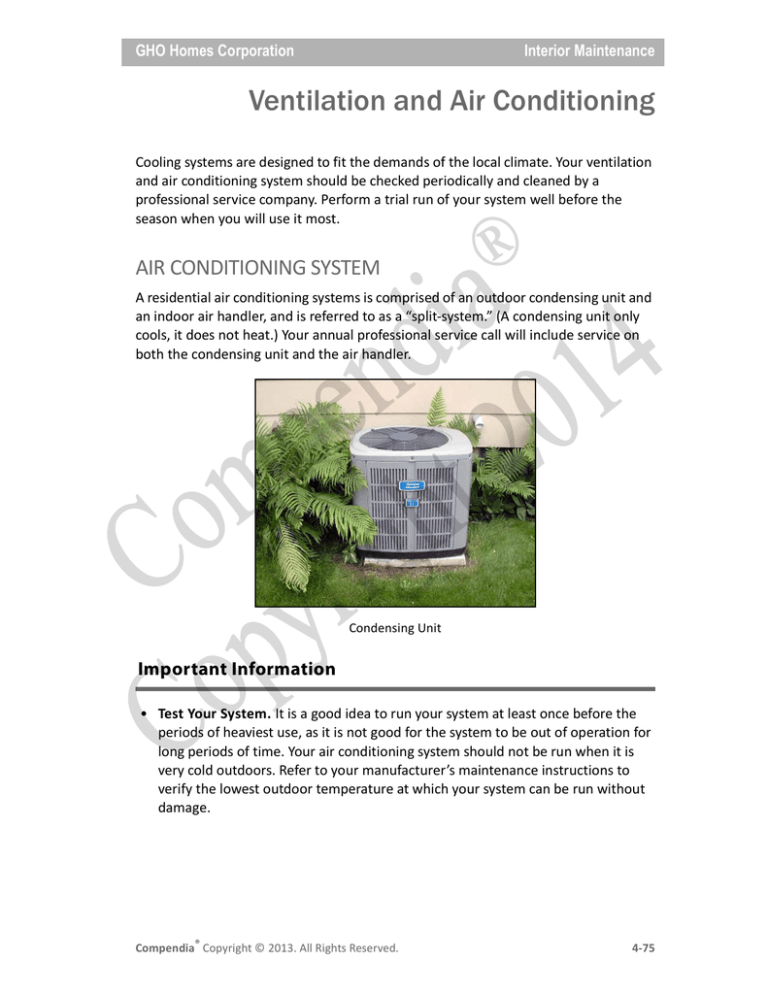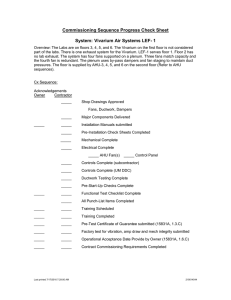
GHO Homes Corporation
Interior Maintenance
Ventilation and Air Conditioning
Cooling systems are designed to fit the demands of the local climate. Your ventilation
and air conditioning system should be checked periodically and cleaned by a
professional service company. Perform a trial run of your system well before the
season when you will use it most.
AIR CONDITIONING SYSTEM
A residential air conditioning systems is comprised of an outdoor condensing unit and
an indoor air handler, and is referred to as a “split-system.” (A condensing unit only
cools, it does not heat.) Your annual professional service call will include service on
both the condensing unit and the air handler.
Condensing Unit
Important Information
• Test Your System. It is a good idea to run your system at least once before the
periods of heaviest use, as it is not good for the system to be out of operation for
long periods of time. Your air conditioning system should not be run when it is
very cold outdoors. Refer to your manufacturer’s maintenance instructions to
verify the lowest outdoor temperature at which your system can be run without
damage.
Compendia® Copyright © 2013. All Rights Reserved.
4-75
Interior Maintenance
GHO Homes Corporation
• Be Practical. Practical approaches, such as using window coverings, are an
important part of your home’s cooling system. For example, on hot days close
drapes, blinds, or shutters to block sunlight. On sunny, cold days, opening your
window coverings may help heat your home. Also, do not leave doors and
windows open for significant periods of time when the cooling system is
operating.
• Use Vacation Settings While Away. If you will be away from your home for more
than a couple of days, do not completely shut off the system. The potential
change in temperature and lack of airflow may cause condensation that may
damage the home.
• Freeze-up Condition Remedy. Under some high humidity conditions, cooling
coils may ice up, stopping the circulation of air through the system. Switch from
the “cool” setting to “fan” until the ice melts; the air conditioning should function
normally when turned back on.
• Trim Landscaping Around the Unit. Keep landscaping trimmed well away from
the outside unit and condensate lines.
• Do Not Run the A/C Fan Continuously. During high humidity conditions, do not
run the air conditioning with the fan set to run continuously. The fan should cycle
on and off with the outdoor (condensing) unit. Continuous fan operation reevaporates moisture from the cooling coil back into the house, raising the indoor
humidity.
• Humidity Control. Set the A/C system thermostat to the “fan-auto” setting to
allow the system to perform the best dehumidification.
Caution: Never close more than 30% of the registers in your home at one time.
Reduced airflow will not only place strain on the HVAC fan unit, but can result in
condensation and water damage in higher humidity rooms.
Warning: If you notice a gas odor, call your gas company immediately.
Recommended Maintenance Tasks
Frequency
Change/clean the air filter, typically monthly during high
use seasons. For reusable filters, vacuum and wash with
detergent and water; allow filter to air dry before
replacing it.
Monthly or per
manufacturer’s
recommendations
Clean the registers to keep them free of dust and debris.
Monthly
4-76
Compendia® Copyright © 2013. All Rights Reserved.
GHO Homes Corporation
Interior Maintenance
Recommended Maintenance Tasks
Frequency
Check the condensate drain lines to ensure that water is
flowing freely.
Seasonally
Examine the condensate drain pan float switch to ensure
it is mounted on the pan properly and that it turns off
the A/C unit when the pan accumulates a significant
amount of water.
Seasonally
Contact a professional service company to service your
system.
Annually or per
manufacturer’s
recommendations
Effects of Deferred Maintenance
Failure to properly maintain and properly use your cooling system may result in
malfunction or premature failure. The air conditioning system cools and, to some
degree, dehumidifies the air. Malfunction of the system may result in poor
dehumidification and increased moisture in the home, resulting in moisture damage
to your home or its contents.
Compendia® Copyright © 2013. All Rights Reserved.
4-77
Interior Maintenance
GHO Homes Corporation
AIR CONDITIONING CONDENSATE PIPES
The air conditioning condensate discharge pipes drain condensed water away from
the A/C system. It must be checked periodically for clear flow to keep your system
operating at maximum efficiency. Serious water damage to your home and its
contents may occur as a direct result of an obstruction to the condensate line.
Know the locations of the primary and secondary condensate discharge pipes. They
are usually white plastic pipes protruding through exterior walls. Water actively
discharging from a secondary condensate pipe is an indication that the primary pipe
is clogged. Have the primary line cleaned right away. The clogged pipe may cause
water leakage, resulting in damage to other building components. An overflow switch
may be installed on the secondary condensate discharge line to shut down the unit
when water overflows into the secondary line. You may want to consider using
algaecide tablets to inhibit biological growth which can lead to blocked drains and
premature pan deterioration.
4-78
Compendia® Copyright © 2013. All Rights Reserved.
GHO Homes Corporation
Interior Maintenance
AIR FILTER
Learn the location of the air filter in your cooling system. The most common air filters
are wall or ceiling units. Many air handling units have slots to insert filters into the air
flow. Although it takes less than a minute to change the filter, this is one of the most
commonly overlooked details. Clean filters provide an even flow of clean air within
your home and reduce system operating costs. Clogged air filters can result in
reduced airflow and colder supply temperature which may cause condensing units to
automatically shut off, causing units to cycle excessively and reduce efficiency. Dirty
filters can also cause streaking on the walls near vents.
Example of an Air Filter Location
Consult the manufacturer’s documentation for the type and location of the air filter
used in the system. Some filters are so tightly meshed that they actually starve the
system of air. Ensure that the new filter is properly fitted so air is properly filtered and
does not bypass the system.
Compendia® Copyright © 2013. All Rights Reserved.
4-79
Interior Maintenance
GHO Homes Corporation
BATHROOM EXHAUST FANS
Exhaust fans play significant role in your home’s ventilation, and are installed in your
bathrooms. The exhaust fans may have filters that need to be cleaned or replaced
periodically. Refer to the manufacturer’s documentation for information on the fans
installed in your home.
Bathroom Exhaust Fan
Important Information
• Use Fan While Showering. Moisture and mildew problems can occur in any
room where water vapor is present. In bathrooms, use the exhaust fan while
showering in order to control indoor humidity. Proper use of the exhaust fans to
control steam can help reduce the potential for mold growth in your shower and
bathroom.
• Disconnect the Power Before Servicing. When filters or filter screening is part
of your exhaust fan assembly, disconnect the power before servicing.
Quick Tip: Fixing a Noisy Fan
If fans become noticeably noisier over time and have otherwise been properly
maintained, have them serviced by a professional.
Recommended Maintenance Tasks
Frequency
Clean reusable filters and screens with soap and water
to remove dust or lint that may have accumulated.
Quarterly
4-80
Compendia® Copyright © 2013. All Rights Reserved.
GHO Homes Corporation
Interior Maintenance
Recommended Maintenance Tasks
Frequency
Replace filters.
Per manufacturer’s
recommendations
If your fans have exterior exhaust vents, inspect and
clean the exterior hood or vent. Ensure that the back
draft damper (flap) is clear and free moving.
Annually
Effects of Deferred Maintenance
Failure to maintain exhaust fans may result in decreased efficiency and performance,
a shortened useful life, and decreased air quality in your home.
Compendia® Copyright © 2013. All Rights Reserved.
4-81
Interior Maintenance
GHO Homes Corporation
CEILING FANS
Ceiling fans are a feature that, when used in conjunction with your HVAC system, can
help evenly distribute cooled or heated air throughout your home, resulting in lower
utility bills.
Ceiling fans require periodic cleaning to keep them looking and working their best.
Consult the manufacturer’s recommendations for model-specific information and
troubleshooting tips. Ceiling fans may require occasional tightening of the
attachment hardware to prevent wobbling or noise during operation.
Ceiling Fan with Light Fixture
Caution: Do not use water, cleansers, harsh rags, or abrasives, as they may
scratch or warp the fan blades. In addition, water may damage the motors and
create the possibility of electrical shock.
Recommended Maintenance Tasks
Frequency
Clean the fan blades with a soft brush or lint free cloth to
remove dust.
Periodically
Replace light bulbs in ceiling fan fixtures. Tighten the
hardware and connections to prevent the unit from
wiggling during use.
As needed
Effects of Deferred Maintenance
Failure to periodically clean and maintain the ceiling fans may result in a build-up of
dust, a diminished appearance, or a decreased performance of the unit.
4-82
Compendia® Copyright © 2013. All Rights Reserved.
GHO Homes Corporation
Interior Maintenance
REGISTERS
Registers (or air vents) distribute conditioned air throughout your home. Room air
returns to the heater and A/C through the return vents. For efficient airflow, keep
furniture, drapes and other objects away from registers. The registers can be adjusted
to provide the desired temperature for each room.
Adjustable Register
Compendia® Copyright © 2013. All Rights Reserved.
4-83
Interior Maintenance
GHO Homes Corporation
THERMOSTAT
Your thermostat controls the HVAC system, and allows you to set the temperature at
which you want your home cooled or heated to. Set your thermostat to a setting
comfortable for you and your family. To maximize energy efficiency, leave your
thermostat at a constant setting to avoid energy-wasting fluctuations. Due to the
demands of energy conservation, thermostats have become quite complex;
familiarize yourself with the manufacturer’s instructions.
Your thermostat has an integrated time delay feature that prevents manually starting
the system repeatedly and protects the compressor from damage. When switching
the thermostat to “ON”, there is normally a delay of up to 15 minutes before the
compressor will switch on.
Keep your home at an even temperature, especially in the first year, to minimize the
expansion and contraction of the building materials. Minor cracking is inevitable but
can be minimized by maintaining a temperature between 68oF–78oF.
Programmable Thermostat
4-84
Compendia® Copyright © 2013. All Rights Reserved.

